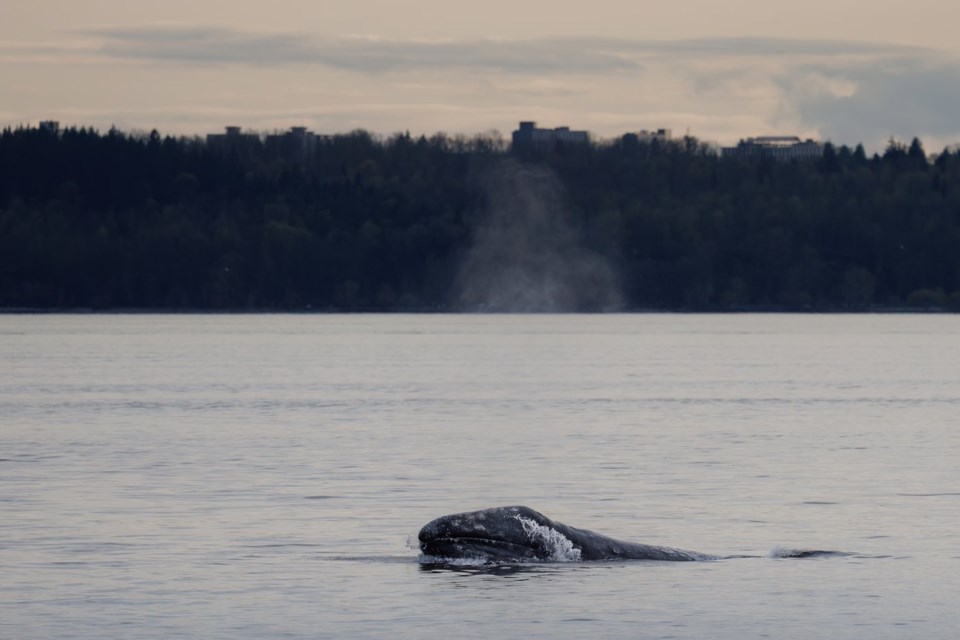VANCOUVER — A grey whale known as Little Patch has been mesmerizing onlookers in the waters off of Vancouver for weeks, sparking a sense of connection as it stops to feed in the busy region before migrating northward.
Cari Siebrits first went to the seawall along the shores of West Vancouver, B.C., on April 9 in hopes of seeing Little Patch, and arrived to find the whale so close to shore she could hear it breathing as it surfaced.
"It's hard to describe the excitement of seeing a whale that close. It feels a little bit like being a kid at Christmas," the North Vancouver resident said.
Siebrits said she immediately called her parents to meet her at the seawall, and the family sat for hours watching the whale as the sun set, surrounded by crowds of people doing the same.
"Everyone was just so captivated and mesmerized by him, you know, watching him slowly feed and move and surface and disappear and reappear," said Siebrits, who is a wildlife photographer.
"It really just made you feel such a profound sense of connection to this bigger world around you," she said.
Siebrits likened the seawall to a classroom, with Little Patch as the teacher, sparking important conversations about marine traffic, conservation, biodiversity and the health of Metro Vancouver waters.
"I think it's really turning all of us into these advocates for the wildlife in our backyard and that's pretty powerful," said Siebrits, adding she recently spotted a pod of transient killer whales in Burrard Inlet.
Jessica Scott, senior manager of the Ocean Wise whales initiative, said Vancouver's harbour typically sees a couple of grey whales each year, so the extended visit by Little Patch is quite rare.
Scott has also seen Little Patch from the West Vancouver seawall.
"He was cruising up and down the shoreline," she said. "They feed in the sand on these little benthic invertebrates. He was likely feeding on ghost shrimp."
Scott said there have also been many sightings of killer whales, harbour porpoises, and Pacific white-sided dolphins in the area.
"As someone who lives in a big city, you don't think there's going to be these opportunities to view wildlife, especially non-invasively from shore," she said.
"I think it really reminds us of our impact on those animals and the fact they are inhabiting these very busy waters."
Little Patch is part of a group of about a dozen grey whales known as "sounders" that break off from the typical migration route to feed in the waters of Washington's Puget Sound, she said.
Scott said researchers first identified Little Patch in 1991, making him about 35 years old, and this spring marks his first-known visit to Vancouver.
The nickname comes from a distinctive white patch on the side of the whale's body, she said.
Metro Vancouver's waters are also brimming with shipping vessels, tankers and recreational boats, and whales face the risk of ship strikes, Scott said.
"Typically, grey whales, humpback whales, they're slow to move away from oncoming vessels," she said, adding the whales are focused on feeding.
"So, it's our responsibility to keep them safe."
The Cascadia Research Collective said in a Facebook post on May 2 that another "sounder" was found dead in San Francisco Bay a month earlier.
A necropsy found a ship strike had killed the whale, said the group, which is based in Washington state.
Scott said anyone on the water, from kayakers to captains of large vessels, should give whales space and report sightings on the WhaleReport app.
"We've delivered over 75,000 alerts to mariners from over a hundred organizations in B.C., Alaska, and Washington state," she noted.
Siebrits said "there's a collective sense of concern" among people who are captivated by Little Patch and feel invested in the whale's well-being.
"I hope it almost extends beyond him, you know, to caring about the wild spaces and wild creatures we share our ocean and our city with."
Frank Lin, a wildlife photographer and educator at the Stanley Park Ecology Society Nature House in Vancouver, has also been a frequent visitor to the seawall since the first sightings of Little Patch last month.
"I still can't believe the shots that I've gotten over the past little while," he said.
In one photo, Lin said he captured Little Patch peeking above the water, with the park's distinctive Siwash Rock towering in the background.
"You could see the huge line of people just looking at him," Lin said. "I could even recognize people I knew from across (the water), like with my camera."
Little Patch and killer whales aren't the only water-dwelling wildlife drawing excited visitors to Stanley Park, Lin said.
"There is one duck that's kind of been bringing people together," he said.
"In the same way as Little Patch, people are wondering about, where is the tufted duck?"
A Eurasian tufted duck recently spent a few days at Lost Lagoon in Stanley Park, Lin said.
He said he's been watching for an "odd one out" as the purplish-black tufted duck blends with similar-looking lesser scaups, which are common in the park.
"It's kind of bringing people together in terms of observing wildlife and appreciating what we have," Lin said.
This report by The Canadian Press was first published May 9, 2025.
Brenna Owen, The Canadian Press



